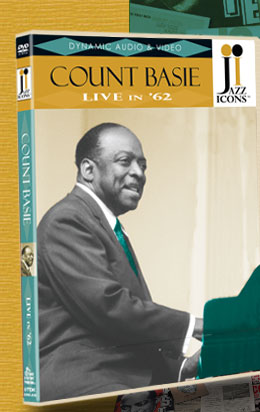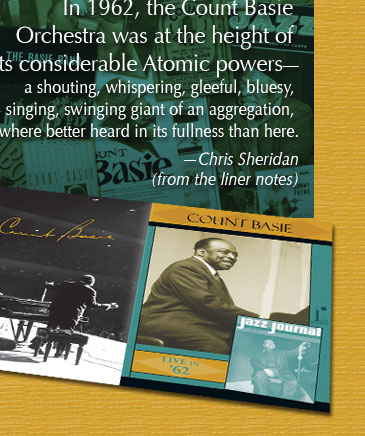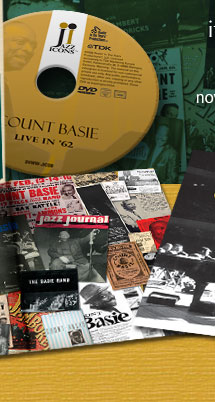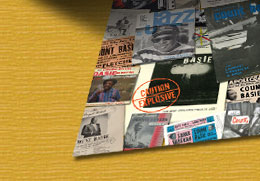




 |
 |
|
|||
|
|
|
||||
|
|
|
||||
|
|
|
||||
|
|
|
||||
 |
|
||||
 |
|
||||
 |
|
||||
|
|
|
|
|
|
|
 |
 |
 |
 |
Jazz Icons: Count Basie features one of the greatest big band orchestras captured at the height of their considerable powers. Billed frequently as the “most explosive force in jazz,” this recently discovered 60-minute concert, taped in Sweden in 1962, highlights the legendary musical talents of this 18-piece band which included such luminaries as Marshal Royal, Freddie Green, Quentin “Butter” Jackson, Frank Wess and sensational drummer Sonny Payne. This is the earliest known complete concert of Count Basie and his orchestra to be released on DVD. Stellar performances include “Corner Pocket,” “Old Man River,” and “One O’Clock Jump.” |
|
 |
|
Piano: Count Basie Alto Sax: Marshal Royal and Frank Wess Tenor Sax: Eric Dixon, Frank Foster, Frank Wess Baritone Sax: Charlie Fowlkes Trumpet: Al Aarons, Sonny Cohn, Thad Jones, Snooky Young Trombone: Henry Coker, Quentin Jackson, Benny Powell Guitar: Freddie Green Bass: Eddie Jones Drums: Sonny Payne Vocal: Irene Reid |
Easin’ It You’re Too Beautiful Corner Pocket Stella By Starlight Back To The Apple I Needs To Be Bee’d With I Got Rhythm Back Water Blues Alexander’s Ragtime Band Old Man River One O’Clock Jump |
16-page booklet Liner notes by Chris Sheridan Cover photo by Raymond Ross Booklet photos by Paul Hoeffler, Herman Leonard, Lee Tanner, William "PoPsie" Randolph, Riccardo Schwamenthal Memorabilia collage Total time: 56 minutes |
|
|
Sample Liner Notes by Chris Sheridan: The performance captured on this wonderful concert DVD features the band that became known as “Atomic” from its 1957 album bearing a dramatic photograph of an atomic bomb explosion on the cover. Curiously, the album was just called “Basie”; nowhere was the word “Atomic” to be seen. But the nickname was swiftly applied–and it stuck, going on to describe the five-year period of the band’s development that climaxed in the year of this concert. It is this moniker that obviously gave rise to the other “explosive force” tag. It is worth recalling that this was a band rebuilt from the ashes of the Swing Era, which by 1950 had seen the virtual end of big bands (Duke Ellington’s being a notable exception). After disbanding his “Old Testament” band that year, Basie led a septet for a couple of years, but the itch to lead a big band had to be scratched, and in 1952 he went back on the road with his “New Testament” band, the forerunner of the one seen here. ... Here in Sweden the stage is set. The back row is for the trumpets, led by the great Thad Jones, a Detroit man and one of the most individual trumpet talents to grace Basie’s bands. Aside from his brilliance as a soloist, Jones was one of the band’s senior arrangers and composers—a man who would go on to develop those talents through his own epoch-making big band. Jones had joined the Basie organisation in 1954 and would remain until early 1963, so his appearance on this DVD is a rare pleasure. Next is Eugene “Snooky” Young, who first joined Basie in the Old Testament days of 1943 (he had a month in the ranks the previous year). With the wanderlust of youth, he had several spells with the band over the next decade until 1957, starting a five year stint which ended in 1962. Upon leaving Basie, Young became a studio trumpeter for NBC and played with The Tonight Show Orchestra until its dissolution in 1992. Born in Dayton, Ohio, in 1919, he was Jimmie Lunceford’s lead trumpet at the age of 20 and shares that duty here with Chicagoan George “Sonny” Cohn. The latter joined in 1960, after 15 years with Red Saunders (eleven of them at the Club DeLisa), and would remain with the band until Basie’s death in 1984, even though the constant travelling initially came as a shock. As section leaders, Young and Cohn would not expect to get much solo work, but both step out here. ... This concert was filmed by SVT (Swedish Television) on April 24, 1962, and an edited half hour programme was broadcast six months later on October 5. As is usual with a Count Basie concert, there is no verbal announcement to identify the opening performance; instead, the announcement lies in Basie’s piano introduction. As if by magic, the rhythm section clicks silkily into gear, and the band is striding impressively towards a clever introduction of its seven brassmen, “Easin’ It.” This piece was written and arranged for the band by Frank Foster, debuted in 1960 and, over the years, its routines have not altered. Taken at one of Basie’s favourite tempos—great for dancers, but with plenty going on in the band to listen to—it sees an unusual soloing sequence unfold. First are the trombones exchanging short sequences – Henry Coker (4 bars), Quentin Jackson (4), Benny Powell (8), Jackson (4), Coker (8), Powell (4) and Jackson with the last word (4). Then it is the turn of the trumpets—three sequences of Al Aarons (4), Sonny Cohn (4), Snooky Young (4) and Thad Jones (4). “And that was the brass section,” Basie exclaims at the end, with just a hint of pride. Now, he names the opening tune and introduces the next, “You Are Too Beautiful,” a warm feature for the romantic tenor sax of Eric Dixon that was not included in the TV broadcast. Dixon’s supple and lyrical work here occasionally reminds one of Ben Webster. A charming performance, one can only speculate why it was never recorded commercially by the band. The arrangement, incidentally, is by Ernie Wilkins, a major architect of the New Testament band, who had left in the mid-1950s to pursue a freelance arranging career. The next performance is introduced only by Basie’s piano and the “splinky splanky” figures that occasioned one of his nicknames get a grin of recognition from bassist Jones—showing why verbal introductions were so often unnecessary. In this case, the tune is a sprightly Basie staple, composed and arranged by Freddie Green in 1955—“Corner Pocket.” In 1961 Sarah Vaughan performed this number with the band under the title “Until I Met You,” with lyrics by Don Wolf. In the years of its existence, they must have played it scores of times, yet the band digs in with such enthusiasm that one may believe this might be the first. Thad Jones takes a great solo full of unexpected twists and turns, followed by Al Aarons and Frank Wess. At the end, Marshal Royal rises from the reed section to conduct, but it is Basie’s barely-seen hand gestures that end the piece. “Stella By Starlight” finds Sonny Cohn’s trumpet poignantly singing a song that had become a favourite for moderns (led by Miles Davis) but played here at a more reflective tempo. Cohn does not stray far from the melody, but his interpretation of it remains quite telling. This is another performance omitted from the original TV broadcast. All words and artwork on this page ©Reelin' In The Years Productions. Unauthorized use is prohibited.
|
|
Site contents ©Copyright 2006 Reelin' In The Years Productions
Site designed by Tom Gulotta